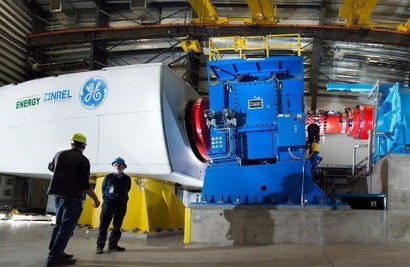
Recently, the Energy Department's National Renewable Energy Laboratory took a giant step forward in the quest for more reliable, lower-cost wind power with the addition of the new 5 MW Dynamometer Test Facility at its National Wind Technology Center.
The new facility dramatically expands the capability of NWTC engineers and their industry partners to verify the performance and reliability of wind turbine drive-train prototypes and commercial machines.
The facility is capable of testing drive-trains up to 5 MW -- large enough to test virtually any land-based turbine—and employs dynamically variable loading capabilities that will allow researchers to better simulate conditions a turbine might experience in the field.
"These new capabilities make this a very special facility, one of the largest and finest of its kind in the world," said NWTC Director Fort Felker.
"It gives NREL an enhanced ability to do comprehensive testing of modern multi-megawatt wind turbine systems in a laboratory environment to verify their performance and reliability before they are widely deployed," he added.
A dynamometer system replaces the rotor and blades of a wind turbine and allows researchers to control the turbine drive-train's mechanical and electrical systems while simulating normal and extreme operating conditions.
Historically, this testing has been done under torque (rotating) loads only. The new state-of-the-art facility at the NWTC, funded with the support of the Energy Department and the American Recovery and Reinvestment Act, incorporates a non-torque loading system into the testing regimen, a hydraulic device that allows for simulation of both the rotational and bending loads that a wind turbine rotor places on a drivetrain.
"The non-torque loading system is what really sets this facility apart from other comparable test sites," NWTC Dynamometer Project Manager Mark McDade said. "This allows us to test the drive-train system with the types of loads that it will see in a real-world application. It's a very important feature for a test apparatus because the adverse impacts these types of loads can have on a system are significant."
The system features a 6 MW motor, which provides the power to a turbine during testing. The motor turns at very high speed and low torque. The motor drives a gearbox, which transforms the output to the high torque and low speed that is appropriate for a wind turbine drive-train. This provides the rotating loads on the test article.
Add to this motorized torque testing the non-torque loading capability unique to the NWTC, and NREL is able to put a wind turbine drive-train through the most realistic loading tests possible in a laboratory.
Dynamometer testing is used by industry to confirm proper operation and reduce the risk of deploying wind turbine prototypes before they are put into service. By reproducing operating conditions in a laboratory environment, engineers can verify the performance of a turbine's systems, including generators, gearboxes, power converters, bearings, brakes, and control systems.
Conducting these tests before deployment is important because unanticipated failures can be detected and corrected early in the development process, leading to a lower cost of ownership for wind farm operators—and ultimately lower-cost wind energy for the consumer.
"These machines are expected to operate reliably in the field, often in harsh conditions, for 20 years or more," Felker said. "The ability to comprehensively test these systems in the lab, to verify their reliability and performance before they go into service, is a critically important capability for the wind industry."
The first tests being done at NREL's new dynamometer facility are on a 2.75-MW wind turbine the Energy Department acquired in partnership with General Electric (GE). The GE system is being used for the calibration and commissioning of the testing equipment in the facility, which will also provide the industry partner with useful data on this particular turbine model.
The NWTC has continued to grow its testing capabilities over time to meet the ever-expanding needs of the wind industry. This is the third dynamometer test facility at the laboratory, adding to the existing capabilities of previously installed 225-kilowatt and 2.5-MW test systems.
The two smaller systems have directly contributed to the growth of the higher-performance, lower-cost, and more reliable wind turbines seen in use today. The new 5-MW facility is the next step forward toward even larger wind systems with increased performance expectations.
"Important basic R&D will be done in this facility to answer the key engineering questions that will allow us to develop the next generation of wind turbine technology," Felker said. "We need to continue to push the cost of energy down while at the same time improving the performance and reliability of these systems. A laboratory environment such as this, where we can seek the answers to these questions is an important step toward meeting those goals."
Photo caption: NREL engineer Scott Lambert (left) and Project Manager Mark McDade discuss calibrations being done on the new dynamometer at the 5-MW Dynamometer Test Facility at NREL's National Wind Technology Center (NWTC). Photo by Dennis Schroeder.
For additional information:

